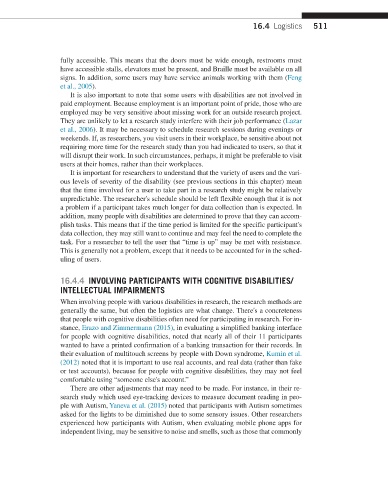Page 518 -
P. 518
16.4 Logistics 511
fully accessible. This means that the doors must be wide enough, restrooms must
have accessible stalls, elevators must be present, and Braille must be available on all
signs. In addition, some users may have service animals working with them (Feng
et al., 2005).
It is also important to note that some users with disabilities are not involved in
paid employment. Because employment is an important point of pride, those who are
employed may be very sensitive about missing work for an outside research project.
They are unlikely to let a research study interfere with their job performance (Lazar
et al., 2006). It may be necessary to schedule research sessions during evenings or
weekends. If, as researchers, you visit users in their workplace, be sensitive about not
requiring more time for the research study than you had indicated to users, so that it
will disrupt their work. In such circumstances, perhaps, it might be preferable to visit
users at their homes, rather than their workplaces.
It is important for researchers to understand that the variety of users and the vari-
ous levels of severity of the disability (see previous sections in this chapter) mean
that the time involved for a user to take part in a research study might be relatively
unpredictable. The researcher's schedule should be left flexible enough that it is not
a problem if a participant takes much longer for data collection than is expected. In
addition, many people with disabilities are determined to prove that they can accom-
plish tasks. This means that if the time period is limited for the specific participant's
data collection, they may still want to continue and may feel the need to complete the
task. For a researcher to tell the user that “time is up” may be met with resistance.
This is generally not a problem, except that it needs to be accounted for in the sched-
uling of users.
16.4.4 INVOLVING PARTICIPANTS WITH COGNITIVE DISABILITIES/
INTELLECTUAL IMPAIRMENTS
When involving people with various disabilities in research, the research methods are
generally the same, but often the logistics are what change. There's a concreteness
that people with cognitive disabilities often need for participating in research. For in-
stance, Erazo and Zimmermann (2015), in evaluating a simplified banking interface
for people with cognitive disabilities, noted that nearly all of their 11 participants
wanted to have a printed confirmation of a banking transaction for their records. In
their evaluation of multitouch screens by people with Down syndrome, Kumin et al.
(2012) noted that it is important to use real accounts, and real data (rather than fake
or test accounts), because for people with cognitive disabilities, they may not feel
comfortable using “someone else's account.”
There are other adjustments that may need to be made. For instance, in their re-
search study which used eye-tracking devices to measure document reading in peo-
ple with Autism, Yaneva et al. (2015) noted that participants with Autism sometimes
asked for the lights to be diminished due to some sensory issues. Other researchers
experienced how participants with Autism, when evaluating mobile phone apps for
independent living, may be sensitive to noise and smells, such as those that commonly

